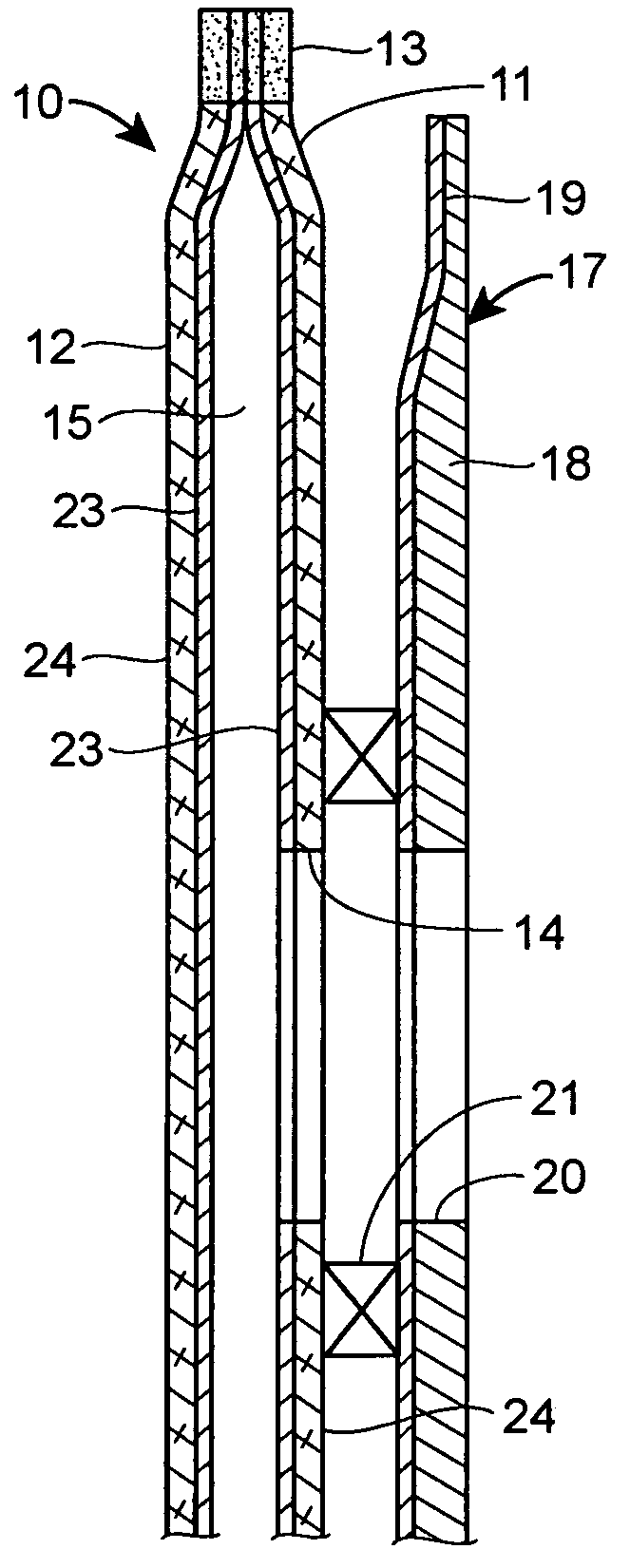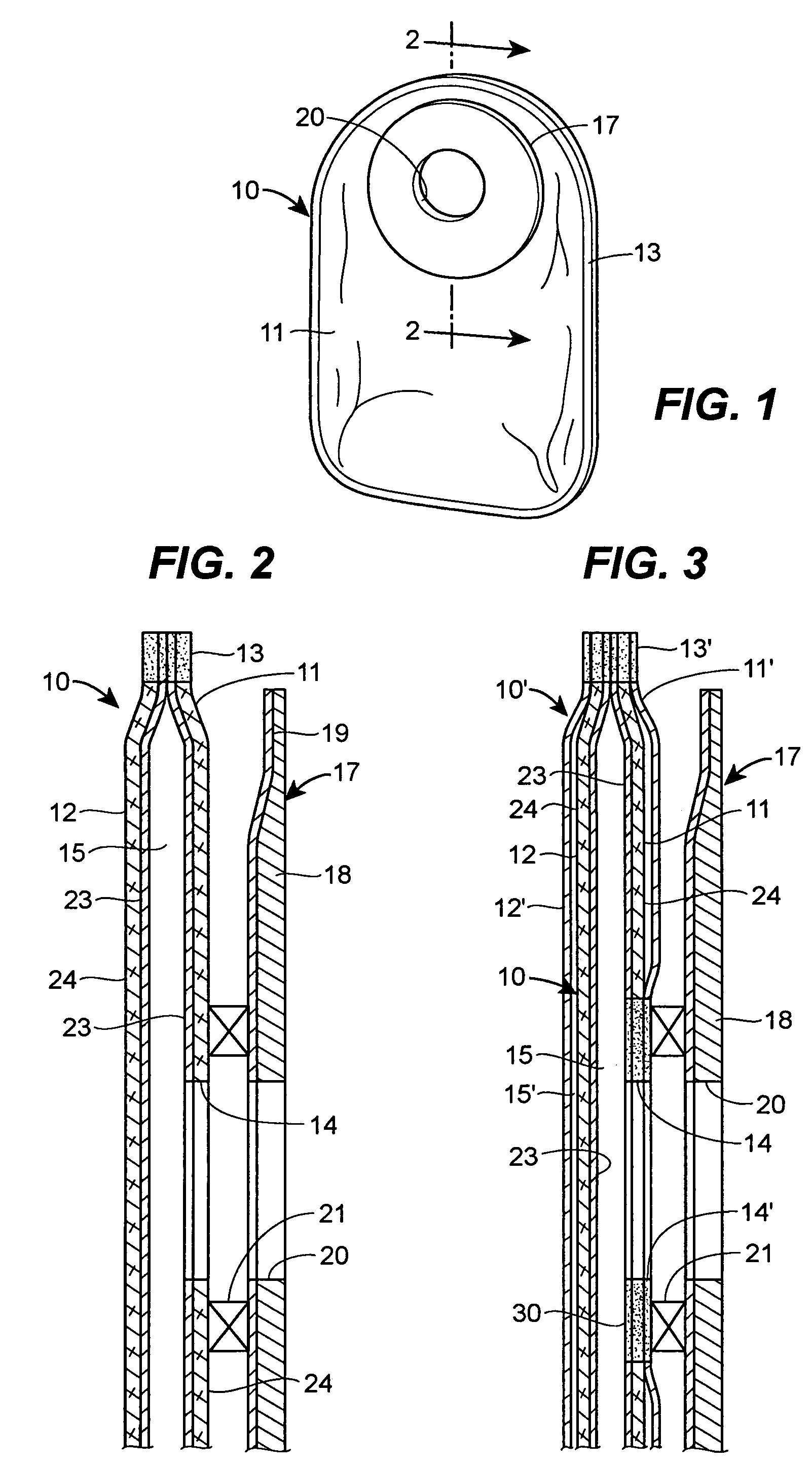Flushable body waste collection pouch, pouch-in-pouch appliance using the same, and method relating thereto
a technology of body waste and pouch, which is applied in the field of biodegradable pouches, can solve the problems of increasing the rate of biodegradation of the film, brittleness and noise, and limited biodegradability, so as to improve the biodegradation rate, minimize noise, and reduce the effect of cos
- Summary
- Abstract
- Description
- Claims
- Application Information
AI Technical Summary
Benefits of technology
Problems solved by technology
Method used
Image
Examples
example 1
[0031]Two methods are particularly suitable for the production of the tissue / film laminate of pouch 10: (1) extrusion coating onto tissue paper (1 step), and (2) film extrusion followed by lamination of the film to tissue paper (2 steps). Extrusion coating may be accomplished using a Davis Standard extrusion coating line. Tissue paper is used as a substrate and the biodegradable polyester is directly extruded onto the tissue in a single step process. With a two-step process, film may be first extruded using a blown film extrusion line and then laminated to paper tissue paper using a Faustel laminator. Lamination is ideally accomplished thermally with no adhesive layer between tissue and film. Both processes (1) and (2) give high quality laminates with no wrinkles or other defects. A two-step process is preferred because it affords better control of the adhesion and interpenetration between tissue and film. A temperature in the 165° to 220° F. range and a nip pressure in the 40–50 ps...
example 2
[0032]Blends of polycaprolactone (“Tone 787” from Dow Chemical) and triethylcitrate (“Citroflex 2” from Morflex Corp.) were compounded and pelletized using a twin-screw compounder extruder. The compounded pellets were converted into film using a cast film line equipped with a 1.25 inch extruder having an L / D ratio of 24:1. Film was extruded at a die temperature of 320° F. The following table illustrates the effect of plasticizer content on tensile modulus and noise at a film thickness of 0.6 mil (15.2 microns):
[0033]
Effect of Triethylcitrate Content (TEC) on TensileModulus and Noise of Polycaprolactone (PCL)PCLUnplasticizedPCL, 10% TECPCL, 20% TECTensile modulus,48200256009950psi(*)Noise(**)dBA696555dB. 8 kHz565141(*)Secant modulus at 2% elongation, ASTM D882 (initial strain rate: 10 in / in min)(**)Film sample is formed into a cylinder and mounted on a test fixture wherein one end is held fixed and the other is rotated around the cylinder axis (15 degree angle, 70 cycles / min). Noise ...
example 3
[0035]As ostomy pouch suitable for use as the inner pouch of a two-pouch appliance was constructed with a thin, plasticized polycaprolactone film of 0.2 to 0.6 mil (5.1 to 15.2 microns) prepared in accordance with Example 2. The pouch was found to flush well even with a low-volume toilet system (1.6 gal).
PUM
| Property | Measurement | Unit |
|---|---|---|
| thickness | aaaaa | aaaaa |
| thickness | aaaaa | aaaaa |
| thickness | aaaaa | aaaaa |
Abstract
Description
Claims
Application Information
 Login to View More
Login to View More - R&D
- Intellectual Property
- Life Sciences
- Materials
- Tech Scout
- Unparalleled Data Quality
- Higher Quality Content
- 60% Fewer Hallucinations
Browse by: Latest US Patents, China's latest patents, Technical Efficacy Thesaurus, Application Domain, Technology Topic, Popular Technical Reports.
© 2025 PatSnap. All rights reserved.Legal|Privacy policy|Modern Slavery Act Transparency Statement|Sitemap|About US| Contact US: help@patsnap.com


